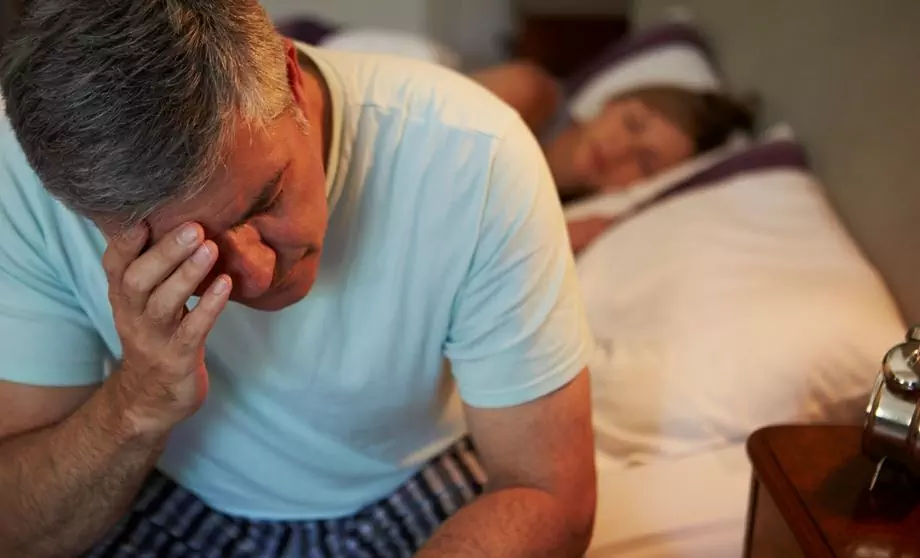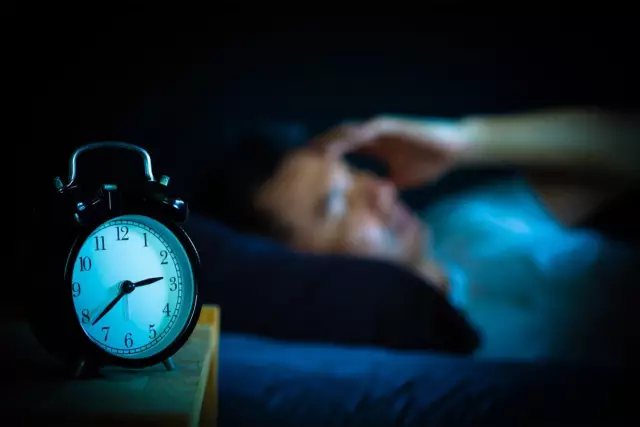- Author Rachel Wainwright [email protected].
- Public 2023-12-15 07:39.
- Last modified 2025-11-02 20:14.
Insomnia
The content of the article:
- Causes and risk factors
- Forms of the disease
- Symptoms
- Diagnostics
- Treatment
- Possible complications and consequences
- Forecast
- Prevention
Insomnia is a sleep disorder that is expressed by superficial, intermittent sleep, delayed onset or premature awakening.

"Insomnia" is a Russian-language analogue of the term "insomnia"
Sleep is a whole spectrum of functional states of the brain; it consists of slow wave sleep (4 stages) and REM sleep.
During slow sleep, the resources of all organs and systems are restored, cellular proteins and ribonucleic acids are replenished, the connection of the central nervous system with subordinate internal organs is optimized. In the phase of REM sleep, the information received during the day is processed and a program of behavior is created for subsequent periods of wakefulness.
Failure to fall asleep, sleep and wake up has serious social and medical consequences.
The International Classification of Sleep Disorders (created in 2005) defines insomnia as “recurrent disturbances in the initiation, duration, consolidation or quality of sleep that occur despite adequate sleep time and conditions and are manifested by various types of daytime disturbances.”
The term "insomnia" is a Russian-language analogue of the term "insomnia", which in the latest International Classification was proposed to denote sleep disorders.
According to the latest data, more than 20% of the world's population suffer from insomnia of various degrees of severity. Insomnia disorders are more common in women, especially in the premenopausal and menopausal periods. Elderly patients are also often subject to insomnia disorders due to the presence of characteristic age-related changes in the sleep-wake regime (shortened sleep time, early morning awakenings).
70-90% of patients with insomnia have concomitant somatic pathology.
Insomnia has significant social consequences: according to the results of various studies, persons suffering from insomnia have a greater (2.5-4.5 times) risk of becoming a participant in a road traffic accident; the working capacity of such persons is reduced at least twice as compared to colleagues.
Causes and risk factors
The causes of insomnia are extremely diverse:
- negative experiences;
- acute or chronic stress;
- astheno-neurotic states;
- psychiatric pathology;
- anxiety and depression;
- taking psychoactive substances;
- alcohol abuse;
- acute and chronic intoxication;
- metabolic diseases;
- changes in hormonal levels;
- diseases of the central nervous system (acute violation of cerebral circulation, neoplasms, epilepsy, parkinsonism, hyperkinetic syndromes);
- sleep syndromes (apnea, physical activity);
- pain syndrome;
- external factors (high noise level, specific climatic conditions, change in the time zone, etc.);
- shift working conditions;
- violation of sleep hygiene.
Forms of the disease
There are several forms of insomnia:
- adaptive insomnia;
- psychophysiological insomnia;
- pseudoinsomnia;
- insomnia against the background of disturbed sleep hygiene;
- behavioral infant insomnia;
- insomnia associated with biorhythm disorder;
- secondary insomnia.
Adaptive insomnia occurs against the background of a sharp change in the usual environment and lifestyle, which lead to hyperactivation of the nervous system. This violation is relatively short-lived: it lasts no more than 3 months.
The psychophysiological form is understood as sleep disorders, in which psychological disorders (for example, fear of sleep) are superimposed on physiological insomnia. In this case, the patient sets himself up to fall asleep as soon as possible, feeling anxiety when this does not happen, thereby aggravating the pathological condition.
Pseudo-insomnia is a special form of insomnia. The patient complains of a complete lack of sleep, but an objective examination reveals full episodes of nocturnal sleep lasting 6.5 hours or more. This condition is associated with a violation of the subjective perception of sleep (only episodes of wakefulness are remembered, the period of direct sleep is amnesiac) and fixation on imaginary sensations.
Sleep hygiene disorders imply a change in the mode of activity in the period preceding falling asleep (drinking strong tea, coffee, intense physical or mental stress).

Drinking strong coffee at night is a violation of sleep hygiene
The leading role in children's behavioral insomnia belongs to the formation of certain associations associated with sleep in a child (motion sickness, reading books, falling asleep together with parents). Attempts to correct the prevailing stereotype entail active resistance from the child, a decrease in sleep time.
Disruption of internal biorhythms leads to a change in the time when the body "gives a signal" about the need for sleep, transferring it to an earlier time (the result is an unusually early awakening) or shifting (making falling asleep at a socially acceptable time impossible).
Secondary insomnia is understood as sleep disorders that develop against the background of somatic diseases.
According to the duration of the course of insomnia is:
- acute (less than 3 weeks);
- chronic (more than 3 weeks);
- transitory (less than 1 week).
Symptoms
All the symptoms characteristic of insomnia can be grouped into 3 main groups: presomnic, intrasomnic, and post-somnic disorders.
Somnic disorders involve falling asleep problems and are represented by the following symptoms:
- fear of not getting sleep;
- the disappearance of the desire to sleep when the patient is in bed;
- the appearance of obsessive thoughts, memories;
- excessive physical activity in an attempt to find a comfortable sleeping position;
- superficial drowsiness, easily interrupted by minimal stimuli (creak of bed, rustle of bed linen, etc.);
- prolonged falling asleep (up to 2 hours or more at a rate of 3-10 minutes).

Sleep fear causes trouble falling asleep
Intrasomnic manifestations:
- frequent nocturnal awakenings, after which it is difficult to fall asleep again;
- superficial, shallow sleep.
Post-somal disorders:
- early awakenings;
- feeling of dissatisfaction, fatigue after a night's sleep;
- daytime sleepiness.

With insomnia, a person feels weak and constantly wants to sleep during the day.
Diagnostics
A number of studies are required to fully diagnose insomnia:
- assessment of the individual chronobiological stereotype (tendency to late or early awakening, duration of sleep required for adequate daytime functioning);
- assessment of working conditions [shift work (daily, night shifts), work on a rotational basis or frequent flights (transfers) with a change in time zones];
- psychological research;
- polysomnographic study, which includes electroencephalographic, electrooculographic and electromyographic studies with subsequent assessment of the results in the aggregate;
- assessment of somatic support (comorbidities that reduce the quality of life and affect the sleep process).

Polysomnographic study is one of the stages of insomnia diagnosis
Treatment
Insomnia treatment is aimed primarily at eliminating the underlying disease that provokes it (intense pain syndrome, shortness of breath, dizziness, dyspeptic symptoms, etc.).
In addition, treatment is carried out in the following areas:
- pharmacotherapy with hypnotics and sedatives (short course to avoid addiction);
- the use of synthetic analogs of the hormone melatonin;
- psychotherapeutic effects (relaxation techniques, methods of limiting stimulation and limiting sleep);
- physiotherapeutic effect;
- correction of sleep patterns, development of positive rituals (especially important for childhood insomnia);
- normalization of sleep hygiene.

Sedatives and hypnotics are effective in treating insomnia, but are not intended for long-term use
Possible complications and consequences
The consequences of insomnia can be very serious:
- decrease in working capacity, learning ability, deterioration of interpersonal interactions in the team;
- depletion of adaptive resources with the subsequent development of somatic diseases;
- exacerbation and aggravation of chronic diseases;
- the formation of psychosomatic pathologies;
- increased risk of injury due to decreased concentration, drowsiness.
Forecast
With an integrated approach to the diagnosis and correction of insomnia, the prognosis is favorable.
Prevention
Prevention of insomnia - achieving high-quality natural sleep. Compliance with hygiene measures can help with this:
- falling asleep at the same time (developing a stereotype of going to bed);
- decrease in the intensity of mental and physical activity at least 1.5 hours before bedtime;
- refusal to use activating substances before bedtime (tea, coffee, tobacco);
- refusal of late meals;
- Providing a comfortable environment for sleeping (well-ventilated room, comfortable bedding, low level of background noise, minimal lighting).
YouTube video related to the article:

Olesya Smolnyakova Therapy, clinical pharmacology and pharmacotherapy About the author
Education: higher, 2004 (GOU VPO "Kursk State Medical University"), specialty "General Medicine", qualification "Doctor". 2008-2012 - Postgraduate student of the Department of Clinical Pharmacology, KSMU, Candidate of Medical Sciences (2013, specialty "Pharmacology, Clinical Pharmacology"). 2014-2015 - professional retraining, specialty "Management in education", FSBEI HPE "KSU".
The information is generalized and provided for informational purposes only. At the first sign of illness, see your doctor. Self-medication is hazardous to health!






